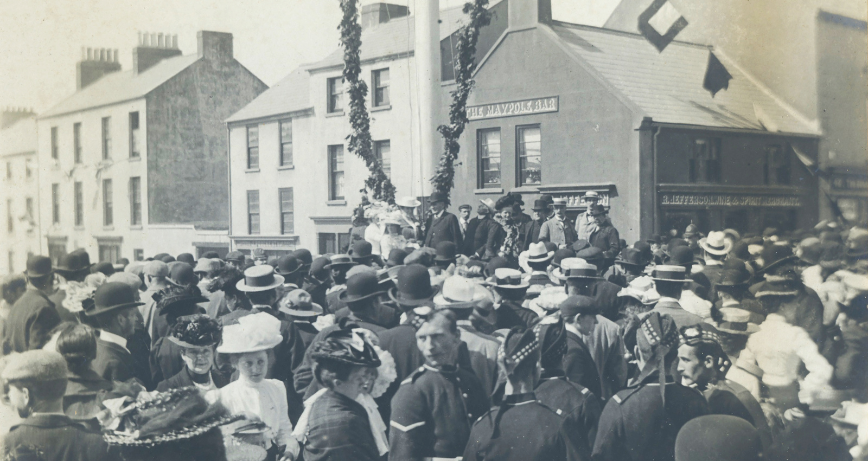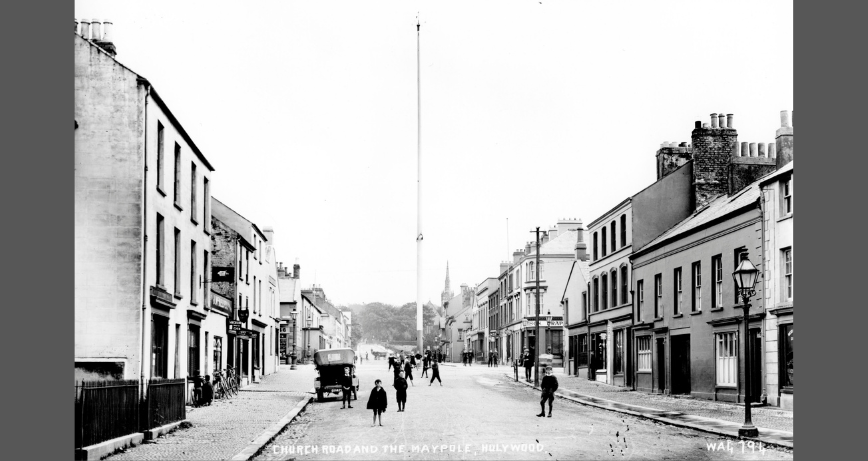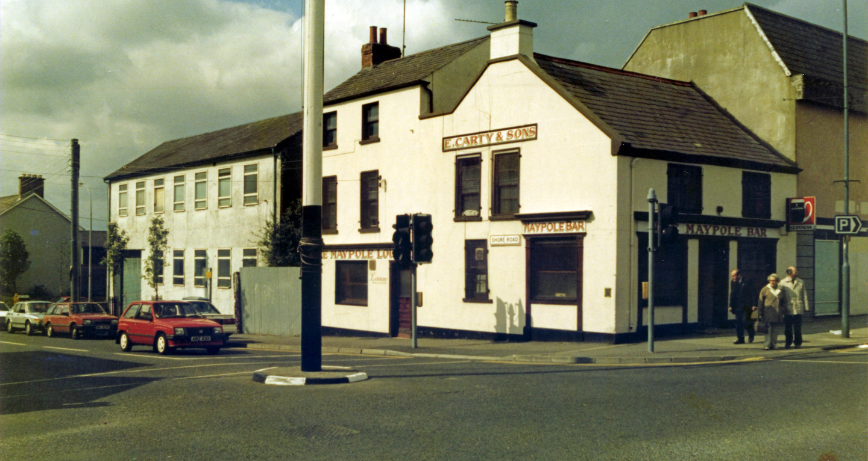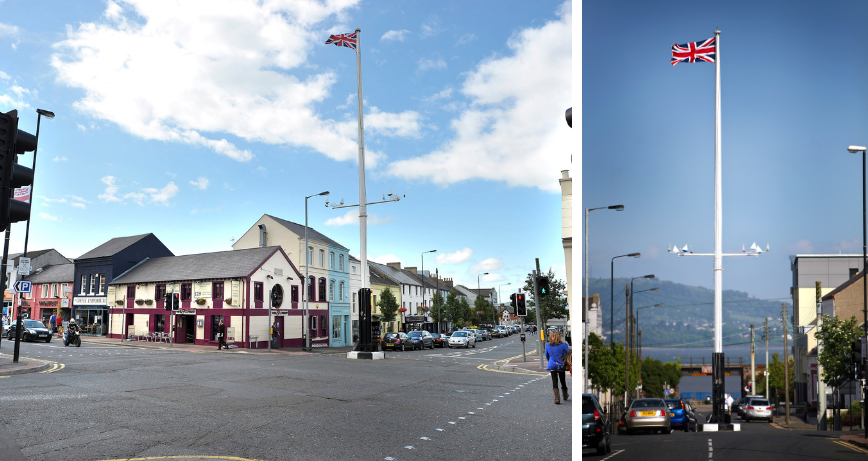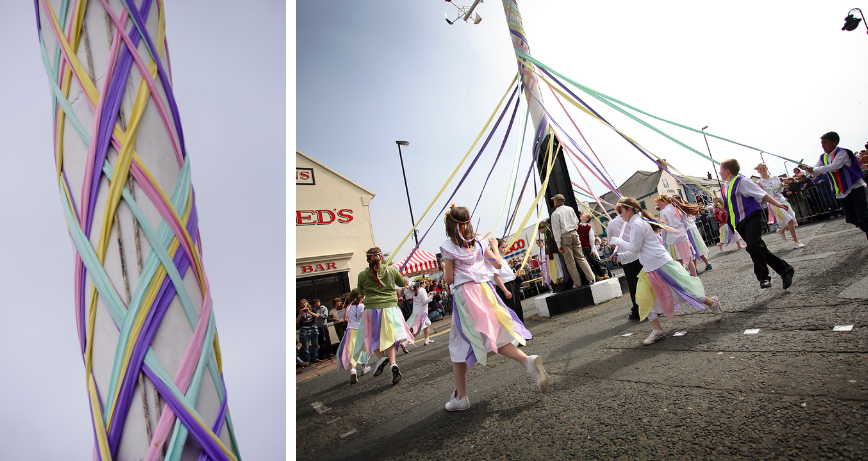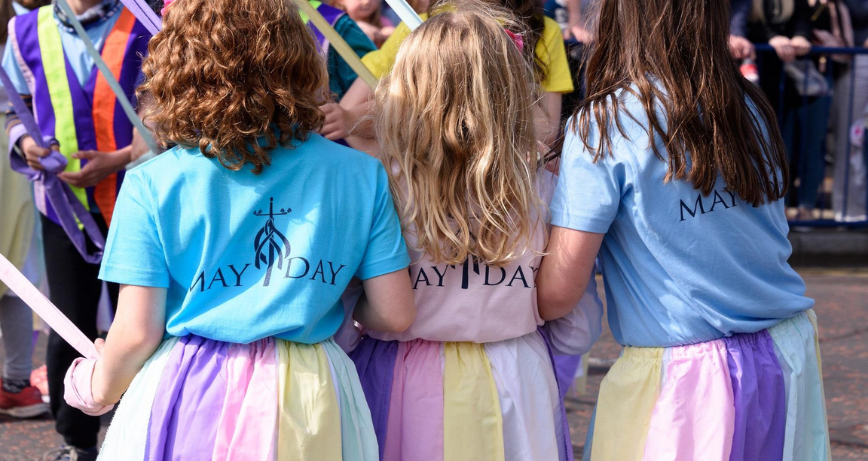The Maypole has been synonymous with Holywood for generations and indeed its history covers centuries. However, did you know there have been numerous different structures over the years, each with their own story to tell…
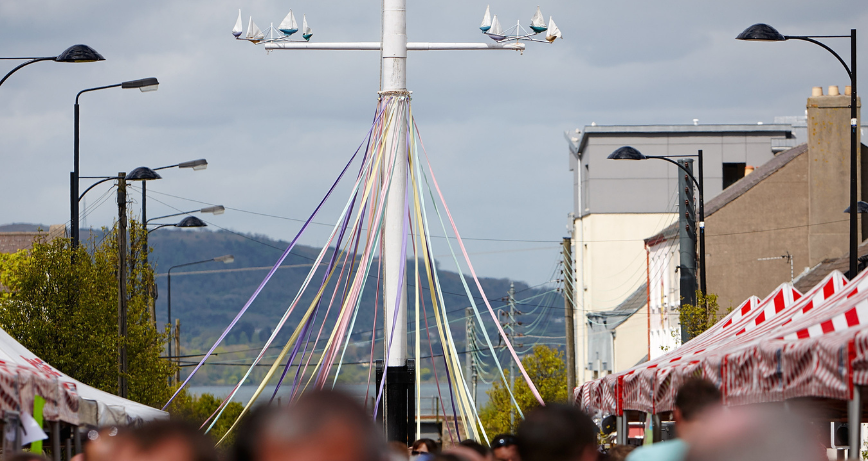
May Day in Holywood
The origins of the Maypole, C17th
According to tradition, the first maypole was originally a ship’s mast which was given as a gift, to the people of Holywood, as a gesture of gratitude for the hospitality. The townspeople had provided assistance to a crew of Dutch traders who were shipwrecked off Belfast Lough near the town. The earliest known depiction of this Maypole can be found in the Raven Maps, on display in North Down Museum. The map shows a wide street around the Maypole which was the centre of the town and home to the weekly market that had been granted by King James to Sir James Hamilton. It also appears to be shorter, this was a common feature of earlier examples.
The Maypole Dressing Ceremony, 1842
The earliest image of the Maypole in it’s more recognisable, great height. The entry in the Belfast and Ulster Directory for 1898 stated: “The Maypole, probably the last of its kind in Ireland, stands at the junction of High Street, Shore Street and Church Street, and is the gift of Captain Harrison, D.L. It is an immense Norwegian spar standing about sixty-four feet above ground and twenty under it. The ceremony of dressing it with, bunting and flowers on May Eve is still continued." The family presented a few Maypoles over the years.
The Representation of the Maypole to the town, 1899
The Maypole was such a part of the DNA of Holywood that the flag was flown at half-mast for local residents, be it those who were born in the town or had lived there for over 50 years. It was also once customary to lower the flag for a passing funeral procession.
An entry in the notebook from Palace Barracks dated 3 November 1899, recorded the funeral of Sergeant McLucas: ‘His body was committed to its last resting place in Holywood cemetery with full military honours… the townspeople showed every sign of respectful sympathy. The window blinds of houses were drawn, and the shutters of shops were closed in the streets through which the solemn cortege proceeded, and on arriving at the maypole… from which the Union Jack was flying at half mast, the flag was dipped in salute as the gun carriage, bearing the coffin, passed.’
A new Maypole, 1902
Captain Harrison presented a new maypole to the town which was inaugurated on 26 June 1902.
Photograph taken at the junction between High St, Chuch Rd, and Shore St, the site of the maypole. It is suggested that the photo was taken around in 1902, possibly in celebration to mark Edward V11th's coronation.
View up Shore Street towards maypole. Year: 1920s
No Maypole
Not all the Maypoles lasted very long. The 1936 version, which stood at an impressive 80 feet above the ground, blew down several years later at noon on 12 February 1943, narrowly missing a bus stopped nearby to collect passengers! Following this Holywood was left without a Maypole for some years.
Second World War
During the Blitz, Arthur Hamblett recalled coming out of the Parish Church School one day, to find an aeroplane sitting at the bottom of Church Road. The plane had travelled along the Bangor Road but was halted by the Maypole which prevented it progressing any further. The solution was to send staff from Shorts to cut the wings off allowing the plane to continue its journey to the airfield. Another resident remembered watching German prisoners marching back to camp in the evening, five abreast, passing the base of the Maypole which had been knocked down by a tank early in the war.
Another new Maypole, 1949
Councillor William Dunn of Tudor Park presented a new Maypole to Holywood in 1949. This example was prepared by Harland and Wolff and towed down the Lough to Holywood. It was an incredible 12ft below ground but it was removed in 1954 for being unsafe. Interestingly it was the first pole to be in the current position, the earlier versions were slightly closer to High Street. It was also at this time that the tradition of Maypole dancing was revived.
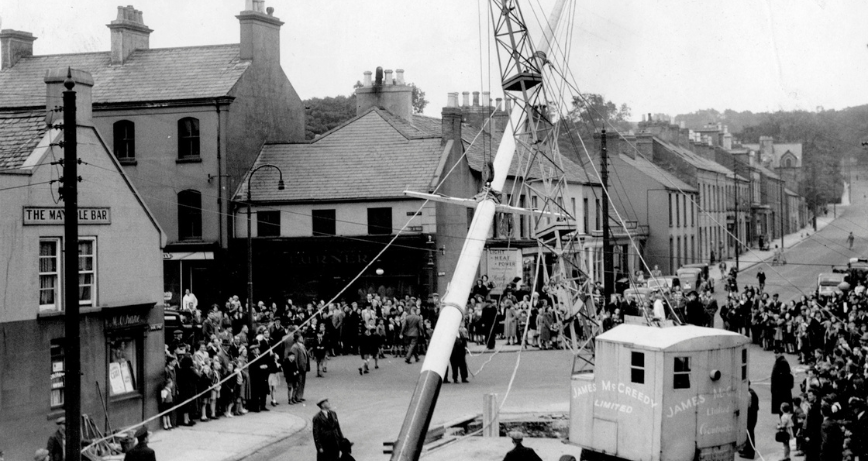
Installation of new maypole in Holywood. Year: October 1949
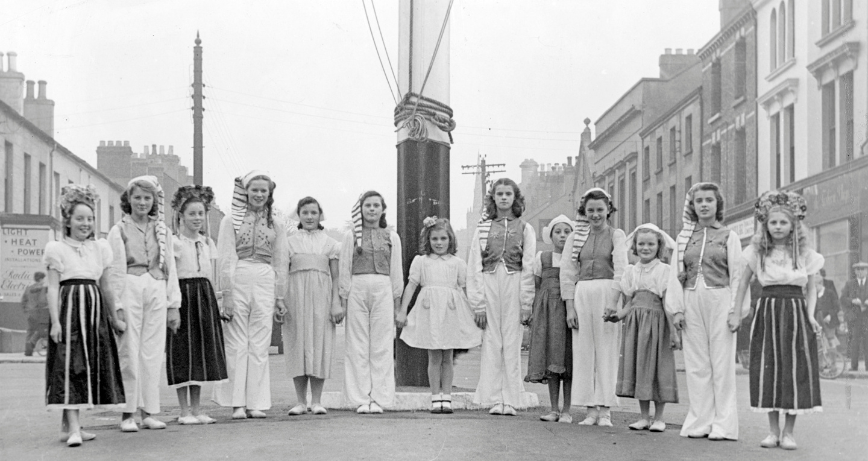
Girls of the Marie Corry School of Dancing at the new maypole. Year: October 1949
First May Queen, 1954
Miss Muriel Rainey, from Cultra, became the first May Queen elected in over a century on 1 May 1954. On the day 16 girls, aged between 6 and 11 danced around the Maypole.
The Maypole evolves, 1957
Although the great height is impressive to view, it forces a substantial portion to be placed below ground which inevitably leads to rot. It was estimated that the lifespan of the Maypole was therefore somewhere between 20 and 30 years. The 1954 version was replaced in 1957, and in 1976 this was shortened to 55ft high, owing to rot affecting the bottom part.
Holywood Maypole, circa 1970s
May Day in Holywood, 1983
The traditional May Day festival complete with dancing, crownings and market was finally fully embraced once more. The event took over the town, with activities focused on High Street which has continued to this day.
Holywood Maypole, circa 2008
Traditional Maypole Dancing by local schoolchildren at Holywood's Maypole
Today's Maypole
The Maypole withstood several large storms in 2020 and 2021 but sadly the top section fell down in February 2021. Fortunately no one was hurt in the incident. It was restored soon after.
May Day dancers
Did you know:
• Holywood was not the only place in Northern Ireland or Ireland to have a Maypole? Other examples are known to have existed across the island, among them were - Ballymena, Downpatrick, Dublin, Kilkenny, Limerick and Maghera. However, Holywood’s example was important due the continued observation of May Day traditions including festooning the Maypole with ribbons and crowning a King and Queen.
• Although we associate maypoles with celebratory dancing, they served a number of purposes from flagpoles to weathervanes or assembly points. However, regardless of their use, they always acted as the centre of their local community.
• Maypole dancing owes its origins to the ancient dances which once took place around living trees in the springtime. These dances were seen as an important fertility rite.
• Towards the late 19th century, the Maypole design was changed:
i. A cross-tree, which carried four small revolving yachts, was added a third of the way up. These were installed at the beginning of May and taken down in September.
ii. The pole was topped by a weathervane and cock (this disappeared for a time before being reinstated). The weather cock symbolised the denial of Jesus Christ by St Peter and acted as a moral reminder to local residents!
iii. Four large gas lamps were also suspended from wrought iron brackets.
Share your stories
Do you have any stories or historic photo's of the Maypole, or do you have any fond memories of the annual May Day event, that you would like to share? Perhaps you were one of the school children who danced around the Maypole? Or a May Queen? Contact us.




